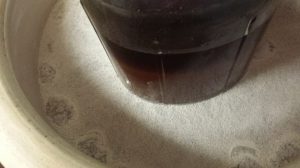More cowbell! This just needs more cowbell! I mean FERMENTATION, this just needs more FERMENTATION. I have to admit that I think I’m completely hooked on fermenting things. We already knew I was thrilled with cheese making and all other things cooking related. This just adds another skill to my list of things I like to do. 😀 The really lovely thing is that it’s not nearly as work intensive as cheese making, which is an all day process (12+ hours sometimes) that has to be carefully monitored. Fermentation is MUCH easier, hooray!
Today’s batch of fermentation is a blend of gold beets, celery root, rainbow carrots, broccoli, cauliflower, onions and garlic. I asked for ideas in a Facebook group on food preservation and they suggested curry. I wasn’t sure about it at first but as I put everything together, the smell of the vegetables spoke to me of curry. I happened to have a good amount of Maharajah curry powder from Penzeys spices. It’s a mild curry with good depth of flavor which I thought would go wonderfully with this.
You can see the beautiful color from the saffron threads in the curry powder. By the time it’s done everything should have a gorgeous golden color. These are half gallon mason jars with air locks on top. You can’t see them but there are clear glass weights on top of the veggies.
Everything will sit in the jars overnight and tomorrow evening I’ll check to make sure enough liquid has been released or if I need to add some brine. The smell is FANTASTIC! Even after washing my hands several times I still smell like curry lol.
I had originally thought about making my own curry blend with whole spices. Finally, the fact that the curry powder needed to be used up combined with the fact that I was getting super tired won the day. I think I’m going to be very glad that I did it this way.
The jar on the left didn’t have enough of the original blend to be full so I added a cabbage on top. I’ve still got a couple of cabbages left so I’ll add them to the sauerkraut pot tomorrow when I’m not so tired. 😉
To the right of the jars you can see a plum and some apples.. I’ve got apples, plums and pears which are going into a jar with a nice pour of Captain Morgan’s Spiced Rum. Because you can never go wrong with fruit and booze. That will be tomorrow’s project though. I’m pretty much done for today. 🙂





